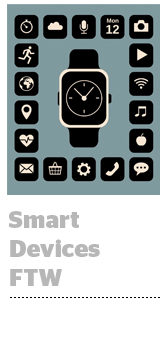 Smartwatches will outpace fitness trackers next year while smart things gain traction in the home.
Smartwatches will outpace fitness trackers next year while smart things gain traction in the home.
Oh yes, and 2016 is the year that mobile browsing will finally surpass desktop, at least on the weekends, according to Adobe’s most recent Digital Trends Index, released Thursday. Weekdays will follow in 2017.
“Mobile is what started all of this,” said Joe Martin, managing analyst at Adobe Digital Index.
The three trends taken together suggest that consumers are starting to embrace the Internet of Things, and it’s all about utility.
One in four US consumers owns a fitness tracker, Adobe found, while 35% of US smartwatch owners primarily use their watch for fitness tracking.
“We see fitness trackers as a gateway to smartwatches,” Martin said, much in the same way iPods gave way to iPhones in the mid-2000s.
It’s a matter of functionality, said Neil Sweeney, president and CEO at JUICE Mobile.
“In the same way the iPhone made the iPod redundant, the watch will make the tracker redundant,” Sweeney said, noting that as the price of smartwatches decreases, adoption will likely go up.
But Acquisio CRO Dave McIninch isn’t putting his money in the smartwatch camp just yet.
“Unless the smartwatch and the fitness tracker see a greater convergence of price points, right now there’s a couple of orders of magnitude of difference between a Fitbit and an Apple Watch, which really isn’t worth it for the incremental increase in functionality,” McIninch said. “[But] if Apple developed a low-cost watch focused on the fitness market, that would do very well because Fitbit and Nike force you off the device to view your stats. If Apple can close that gap, they’d move the needle.”
Data from Fluent also suggest that smartwatches aren’t yet on target to replace sole purpose fitness trackers, most likely due to the price issue, but Fluent CMO Jordan Cohen said his company predicts domestic smartwatch ownership will rise north of 10% following the 2015 holiday season.
Smart device adoption is also picking up steam in the home, with 51% of consumers stating that they’ve already interacted with a home electronic Internet of Things (IoT) device, according to Adobe, whose report predicts that one in five homes will have a smart thermostat, home security system or smoke detector by the end of 2016.
“Social sentiment for these IoT devices is really high – 65% of people are happy with or anticipate these devices,” Martin said. “But it’s also true that we are in the honeymoon stage of the Internet of Things.”
And after the honeymoon comes the reality. Although Adobe’s report didn’t note any negative sentiment around IoT and privacy, it’s certainly going to be a consideration on the horizon.
“As far as privacy goes, IoT is the biggest potential violator of privacy rights beyond detailed web history and maybe mind reading,” McIninch said. “IoT can tell a third party, that really [just] has implied consent, where you are and what you’re doing, [and] that’s a responsibility that one cannot take lightly.”
But it’s still early days for the IoT. Just because consumers are lusting after Nests doesn’t mean that we’re in the movie “Her” just yet.
“We certainly see smart device penetration growing, although not to the scale yet as you might see in a futuristic movie, with all devices featuring connectivity,” said engage: BDR CEO Ted Dhanik.
That said, as consumers upgrade their appliances in the coming year and beyond they’ll likely go with the smart option, especially when it comes to TVs, Sweeney said,
“People don’t buy new TVs every year, nor do they buy new washers and dryers every year,” Sweeney said. “But the market and demand for connected devices is going to definitely grow.”
Adobe’s Digital Trends Index tapped data from a survey of 400 US smartphone and/or tablet owners, more than 200 million social engagements and data points gathered from 255 billion branded website visits.













